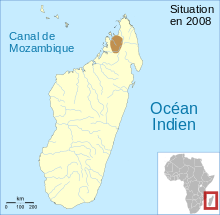Spinomantis massi
Spinomantis massi is a species of frog in the mantellid subfamily Mantellinae. It is endemic to the humid forests of northwestern Madagascar.[1][2]
| Spinomantis massi | |
|---|---|
| Scientific classification | |
| Kingdom: | Animalia |
| Phylum: | Chordata |
| Class: | Amphibia |
| Order: | Anura |
| Family: | Mantellidae |
| Genus: | Spinomantis |
| Species: | S. massi |
| Binomial name | |
| Spinomantis massi | |
 | |
| Synonyms[2] | |
| |
Taxonomy
This species was described in the genus Mantidactylus, subgenus Spinomantis, by Frank Glaw and Miguel Vences in 1994.[3][4] The species is named massi to congratulate the daughter of Frank Glaw, Andrea Mass née Glaw, and her husband Robert Mass, on their marriage. Therefore, plural form massorum should have been used,[5] but this is considered an unjustified emendation. The correct specific name is therefore massi.[2]
Description
Adult males measure 33–42 mm (1.3–1.7 in) in snout–vent length (SVL); the only known adult female measured 38 mm (1.5 in). The head is wider than long. The tympanum is distinct. The fingers and toes bear enlarged, triangular disks. Males have a subgular vocal sac.[6]
Habitat and ecology
Its natural habitats are primary forest near streams at elevations of 300–1,750 m (980–5,740 ft) above sea level. It is an arboreal species that breeds in streams. It is threatened by habitat loss caused by subsistence agriculture, timber extraction, charcoal manufacture, the spread of invasive eucalyptus, and expanding human settlements.[1]
References
- IUCN SSC Amphibian Specialist Group (2016). "Spinomantis massi". IUCN Red List of Threatened Species. 2016: e.T57502A84174100. doi:10.2305/IUCN.UK.2016-1.RLTS.T57502A84174100.en.
- Frost, Darrel R. (2016). "Spinomantis massi (Glaw and Vences, 1994)". Amphibian Species of the World: an Online Reference. Version 6.0. American Museum of Natural History. Retrieved 23 January 2017.
- Glaw, Frank; Vences, Miguel (1994). A Fieldguide to the Amphibians and Reptiles of Madagascar (2nd ed.). Cologne, Germany: Vences & Glaw Verlags GmbH.
- Glaw, Frank; Vences, Miguel (2006). "Phylogeny and genus-level classification of mantellid frogs (Amphibia, Anura)". Organisms, Diversity & Evolution. 6 (2006): 236–253. doi:10.1016/j.ode.2005.12.001.
- Beolens, Bo; Watkins, Michael; Grayson, Michael (22 April 2013). The Eponym Dictionary of Amphibians. Pelagic Publishing. p. 137. ISBN 978-1-907807-42-8.
- Cramer, Abigail F.; Rabibisoa, Nirhy H.C.; Raxworthy, Christopher J. (2008). "Descriptions of two new Spinomantis frogs from Madagascar (Amphibia: Mantellidae), and new morphological data for S. brunae and S. massorum" (PDF). American Museum Novitates. 3618 (1): 1–22. doi:10.1206/594.1. hdl:2246/5924.
